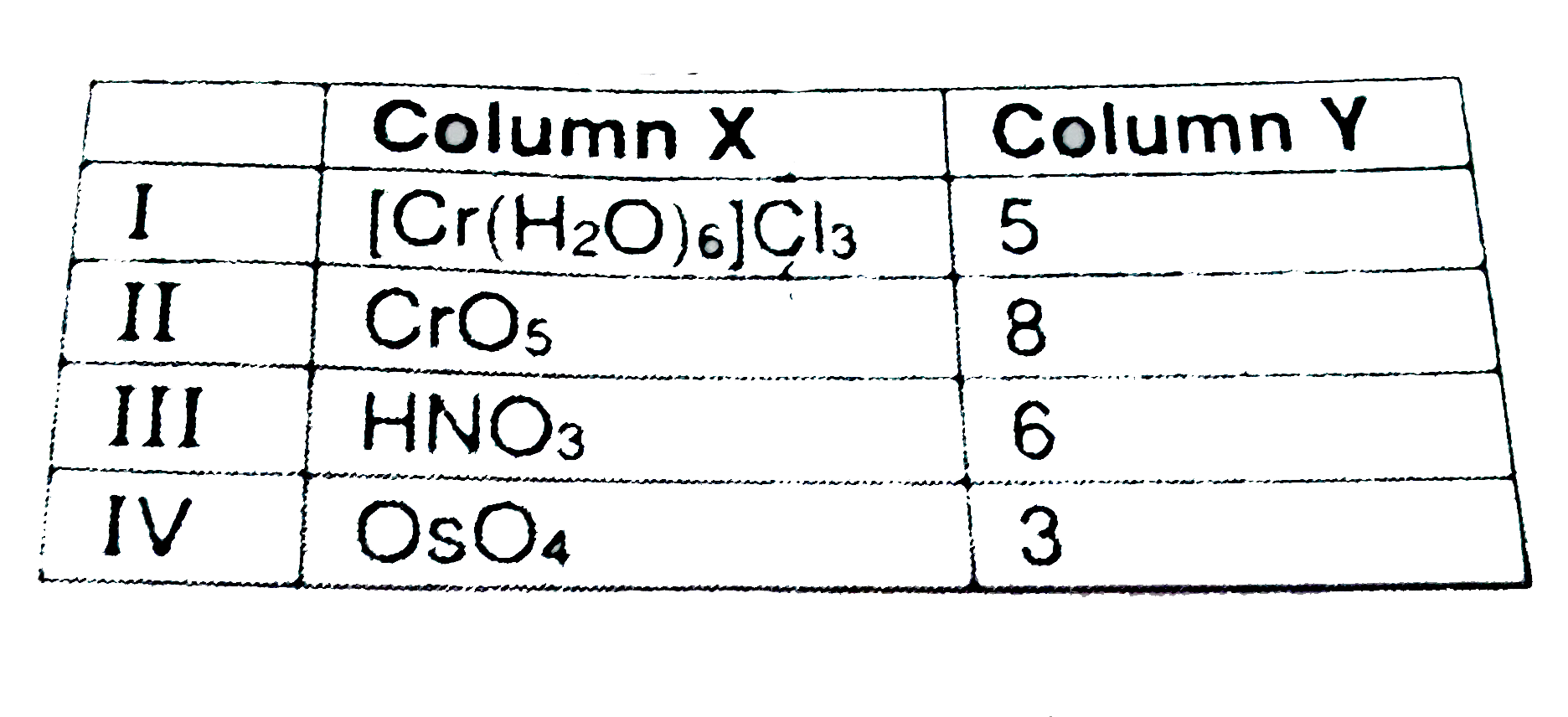Complete Solutions to Exercise 2 of chapter D & F-BLOCK ELEMENTS & THEIR IMPORTANT COMPOUNDS of Class 11 book with complete answers and questions
| Class 11 | CHEMISTRY |
| Chapter | D & F-BLOCK ELEMENTS & THEIR IMPORTANT COMPOUNDS |
| RESONANCE NEW | Exercise 2 |
| Number Of Questions | 40 |
| Academic Year | 2023-24 |
Match the compounds of column X with oxidation state of central atom in column Y.
 .
.
View SolutionStandard reduction electrode potential of `Zn^(2+)//Zn` is -0.76V`. This means:
View SolutionOf the ions `Zn^(2+),Ni^(2+) and Cr^(3+)` (atomic number Zn=30,Ni=28,Cr=24):
View Solutionwhich of the following group of ion is paramagnetic in nature:
View Solutionwhich forms interstitial compounds?
View SolutionWhen `H_(2)O_(2)` is added to an acidified solution of `K_(2)Cr_(2)O_(7)`
View SolutionSodium thiosulphate is used in photography because of its:
View SolutionWhat happens when:
Ferrous sulphate crystal are heated.
View SolutionWhich of the following is not an actinoid?
View SolutionThe correct statement(s) from among the following is/are?
(i). all the d and f-block elements are metals
(ii). all the d and f-block elements form coloured ions
(iii). All th d- and f-block elements form paramagnetic ions
View SolutionWhich of the following statements is not correct?
View SolutionTotal number of 3d-series transition elements contain either `3d^(1)` or `4s^(1)` orbital in their ground state electric configuration.
View SolutionHow many of the following show variable oxidation states in their compounds?
Sc,Cr,Cu,Zn,Fe,Hg,La
View SolutionMagnetic moment value for a d-block ion is 4.90 BM determine value of total spin for it (consider clock wise spin).
View SolutionDetermine total number of unpaired electrons in following ions
`Ti^(3+),V^(3+),Cr^(3+),Mn^(3+),Mn^(2+),Fe^(3+),Fe^(2+),Co^(2+),Ni^(2+),Cu^(2+)`.
View SolutionA black mineral (A) on heating in presence of air gives a gas (B). (A) and (B) are respectively:
View SolutionWhat happens when a solution of potassium iodide is added to a solution of lead nitrate taken in a test tube?
View Solution`KMnO_(4)underset(R.A.)overset(H^(+))toMn^(x)`
`KMnO_(4)underset(R.A.)overset(OH^-)toMn^(y)`
`x+y`
View SolutionThe no. of electrons satisfying n+l=7 for Lu (atomic number:71)
View SolutionCorrect statements about transition metals are that they:
View SolutionTransition elements have greater tendency to form complexes because
View SolutionTitanium dioxide is added in the interior paints for walls of rooms, halls and galleries to give:
View SolutionThe melting point of `Zn` is lower as compared to those of the other elements of `3d` series because:
View SolutionThe less stable oxidation state of `Cr` are:
View SolutionWhich of the following statement is/are correct?
View SolutionSelect correct statement(s).
View SolutionThe colour of the transition metal ions is/are due to:
View SolutionWhich of the following chemical reaction(s) is/are involved in developing of photographic plate?
View SolutionWhich of the following statement are correct when a mixture of `NaCl` and `K_(2)Cr_(2)O_(7)` is gently warmed with conc.`H_(2)SO_(4)`?
View SolutionMonazite is the ore of:
View SolutionPyrolusite is used to prepare potassium permanganate `MnO_(2)overset(X)toMnO_(4)^(2)overset(Y)toMnO_(4)`X and Y are
View SolutionWhich is not a mineral of aluminium?
View SolutionTransition metals usually from coloured complexes and d-d transitions `(t_(2g)hArre_(g))` are responsible for colour as the energy difference between `t_(2g)` and `e_(g)` lies in visible region. But all the coloured ions are not dut to d-d transition but charge transfer bands also play important roles. Charge transfer bands may be of two types.
(i) ligand to metal (CTLM)`" "(ii)` metal to ligand (CTML).
Charge transfer transition always produces intense colour as compared to d-d transition.
Select the incorrect statement `:`
View SolutionTransition metals usually from coloured complexes and d-d transitions `(t_(2g)hArre_(g))` are responsible for colour as the energy difference between `t_(2g)` and `e_(g)` lies in visible region. But all the coloured ions are not dut to d-d transition but charge transfer bands also play important roles. Charge transfer bands may be of two types.
(i) ligand to metal (CTLM)`" "(ii)` metal to ligand (CTML).
Charge transfer transition always produces intense colour as compared to d-d transition.
`MnO_(4)^(-)` is dark purple coloured though Mn is in `(+VII)` oxidation state with `3d^(@)` configuration
View SolutionName the compound which gives blue colour to the glass.
View SolutionPyrolusite ore on oxidation with `KCIO_(3)//KNO_(3)` in basic medium produces dark green coloured compound `(A)`, which on electrolysis produces a purple coloured compound `(B)`. The purple coloured rhombic prisms. It shows different reactions in different mediums.
Excess of compounds (B) on heating with conc. `H_(2)SO_(4)` gives an explosive oil (C ), which on heating decomposes to gives another compound (D ) along with oxygen.
The nature of compound (C ) is `:`
View SolutionPyrolusite ore on oxidation with `KCIO_(3)//KNO_(3)` in basic medium produces dark green coloured compound `(A)`, which on electrolysis produces a purple coloured compound `(B)`. The purple coloured rhombic prisms. It shows different reactions in different mediums.
Excess of compounds (B) on heating with conc. `H_(2)SO_(4)` gives an explosive oil (C ), which on heating decomposes to gives another compound (D ) along with oxygen.
Identify (D).
View Solution .
.
Q. Which combination is correct:
View Solution .
.
Q. Which combination is/are not correct
View Solution .
.
Q. Which combination is correct for Ni.
View Solution
Exercise 2 questions and complete solutions for chapter D & F-BLOCK ELEMENTS & THEIR IMPORTANT COMPOUNDS of RESONANCE ENGLISH of Class 11
All Exercises from RESONANCE NEW Class 11 CHEMISTRY D & F-BLOCK ELEMENTS & THEIR IMPORTANT COMPOUNDS
- Additional Problems for Self practice (APSP)
- Exercise 1
- Exercise 2
- Exercise 3
- High Level Problems
- Match the column
- Miscellaneous Solved Problems
- National Standard Examination In chemistry
- One Integer Value Correct Type.
- One or more than one options correct type
- Only one option correct type
- Paragraph
- Single And Double Value Integer Type
- Subjective Questions